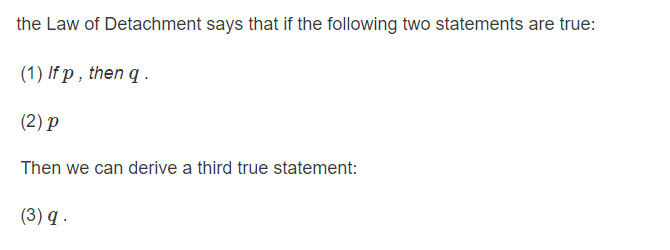- Which law can be used to determine that statement (3) is a valid conclusion to statements (1) and (2)? (1) If an angle is acute, then it cannot be obtuse. (2) ZA is acute.
- Which law can be used to determine that statement (3) is a valid conclusion to statements (1) and (2)? (1) If an angle is acute, then it cannot be obtuse. (2) ZA is acute.
Elementary Geometry For College Students, 7e
7th Edition
ISBN:9781337614085
Author:Alexander, Daniel C.; Koeberlein, Geralyn M.
Publisher:Alexander, Daniel C.; Koeberlein, Geralyn M.
ChapterP: Preliminary Concepts
SectionP.CT: Test
Problem 1CT
Related questions
Question
Which law can be used to determine that statement (3) us a valid conclusion to statements (1) and (2)?

Transcribed Image Text:hen he finishes one loop arour
34. Which law can be used to determine that statement (3) is a valid
conclusion to statements (1) and (2)?
(1) If an angle is acute, then it cannot be obtuse.
(2) ZA is acute.
(3) ZA cannot be obtuse
A. Law of Detachment
B. Law of Syllogism
C. Statement (3) does not follow.
D. Law of Converse
35. True or false: Two statements joined with the word 'or' is called a
conjunction.
Expert Solution
Step 1
G
Law of detachment

Step by step
Solved in 2 steps with 1 images

Recommended textbooks for you

Elementary Geometry For College Students, 7e
Geometry
ISBN:
9781337614085
Author:
Alexander, Daniel C.; Koeberlein, Geralyn M.
Publisher:
Cengage,

Elementary Geometry for College Students
Geometry
ISBN:
9781285195698
Author:
Daniel C. Alexander, Geralyn M. Koeberlein
Publisher:
Cengage Learning

Elementary Geometry For College Students, 7e
Geometry
ISBN:
9781337614085
Author:
Alexander, Daniel C.; Koeberlein, Geralyn M.
Publisher:
Cengage,

Elementary Geometry for College Students
Geometry
ISBN:
9781285195698
Author:
Daniel C. Alexander, Geralyn M. Koeberlein
Publisher:
Cengage Learning